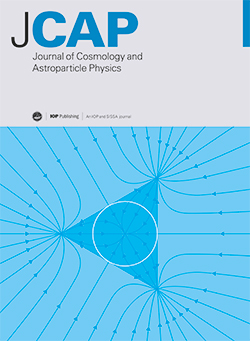Mitigating imaging systematics for DESI 2024 emission Line Galaxies and beyond
IF 5.9
2区 物理与天体物理
Q1 ASTRONOMY & ASTROPHYSICS
Journal of Cosmology and Astroparticle Physics
Pub Date : 2025-07-03
DOI:10.1088/1475-7516/2025/07/018
引用次数: 0
Abstract
Emission Line Galaxies (ELGs) are one of the main tracers that the Dark Energy Spectroscopic Instrument (DESI) uses to probe the universe. However, they are afflicted by strong spurious correlations between target density and observing conditions known as imaging systematics. In this paper, we present the imaging systematics mitigation applied to the DESI Data Release 1 (DR1) large-scale structure catalogs used in the DESI 2024 cosmological analyses. We also explore extensions of the fiducial treatment. This includes a combined approach, through forward image simulations (Obiwan) in conjunction with neural network-based regression, to obtain an angular selection function that mitigates the imaging systematics observed in the DESI DR1 ELGs target density. We further derive a line of sight selection function from the forward model that removes the strong redshift dependence between imaging systematics and low redshift ELGs. Combining both angular and redshift-dependent systematics, we construct a three-dimensional selection function and assess the impact of all selection functions on clustering statistics. We quantify differences between these extended treatments and the fiducial treatment in terms of the measured 2-point statistics. We find that the results are generally consistent with the fiducial treatment and conclude that the differences are far less than the imaging systematics uncertainty included in DESI 2024 full-shape measurements. We extend our investigation to the ELGs at 0.6 < z < 0.8, i.e., beyond the redshift range (0.8 < z < 1.6) adopted for the DESI clustering catalog, and demonstrate that determining the full three-dimensional selection function is necessary in this redshift range. Our tests showed that all changes are consistent with statistical noise for BAO analyses indicating they are robust to even severe imaging systematics. Specific tests for the full-shape analysis will be presented in a companion paper.DESI 2024发射线星系及以后的缓和成像系统
发射线星系(ELGs)是暗能量光谱仪器(DESI)用来探测宇宙的主要示踪剂之一。然而,它们受到目标密度和被称为成像系统的观测条件之间的强虚假相关性的影响。本文介绍了用于DESI 2024宇宙学分析的DESI数据发布1 (DR1)大尺度结构目录的成像系统缓解方法。我们还探讨了基础治疗的扩展。这包括一种组合方法,通过前向图像模拟(Obiwan)与基于神经网络的回归相结合,获得一个角度选择函数,以减轻在DESI DR1 ELGs目标密度中观察到的成像系统。我们进一步从正演模型中推导出视线选择函数,该函数消除了成像系统和低红移elg之间的强红移依赖性。结合角度和红移相关的系统学,我们构建了一个三维选择函数,并评估了所有选择函数对聚类统计的影响。我们根据测量的2点统计量来量化这些扩展治疗和基础治疗之间的差异。我们发现结果与基准处理基本一致,并得出结论,差异远小于DESI 2024全形状测量中包含的成像系统不确定性。我们将研究扩展到0.6 < z < 0.8的elg,即超出DESI聚类目录采用的红移范围(0.8 < z < 1.6),并证明在该红移范围内确定完整的三维选择函数是必要的。我们的测试表明,BAO分析的所有变化都与统计噪声一致,表明它们即使对严重的成像系统也具有鲁棒性。全形状分析的具体测试将在配套论文中介绍。
本文章由计算机程序翻译,如有差异,请以英文原文为准。
求助全文
约1分钟内获得全文
求助全文
来源期刊

Journal of Cosmology and Astroparticle Physics
地学天文-天文与天体物理
CiteScore
10.20
自引率
23.40%
发文量
632
审稿时长
1 months
期刊介绍:
Journal of Cosmology and Astroparticle Physics (JCAP) encompasses theoretical, observational and experimental areas as well as computation and simulation. The journal covers the latest developments in the theory of all fundamental interactions and their cosmological implications (e.g. M-theory and cosmology, brane cosmology). JCAP''s coverage also includes topics such as formation, dynamics and clustering of galaxies, pre-galactic star formation, x-ray astronomy, radio astronomy, gravitational lensing, active galactic nuclei, intergalactic and interstellar matter.
 求助内容:
求助内容: 应助结果提醒方式:
应助结果提醒方式:


